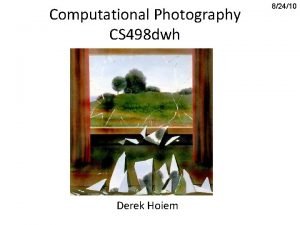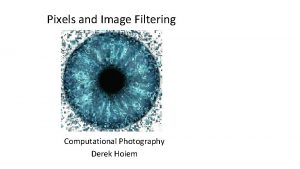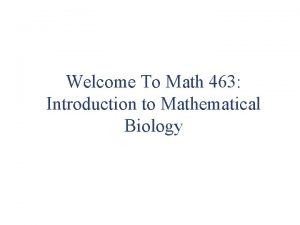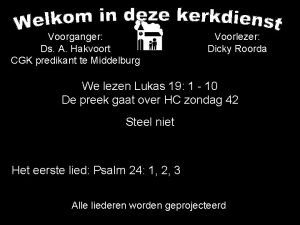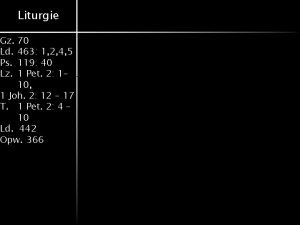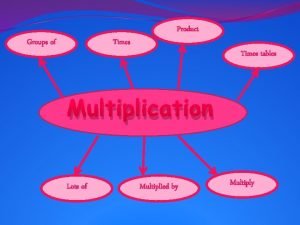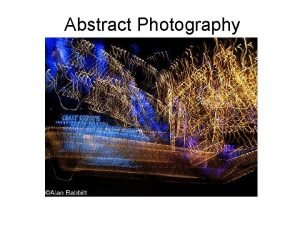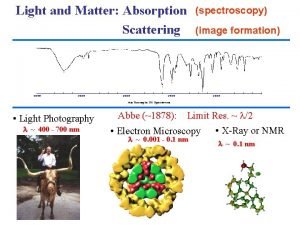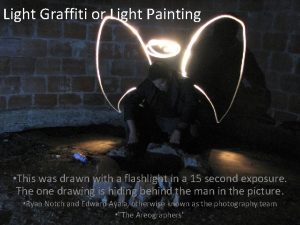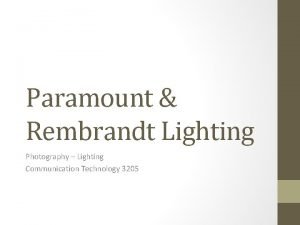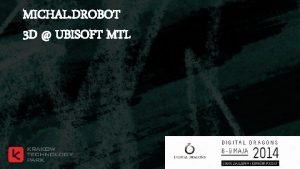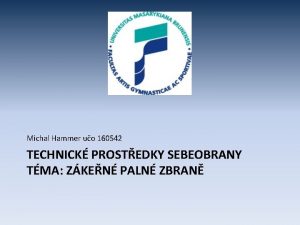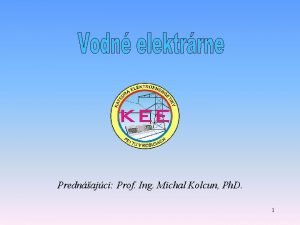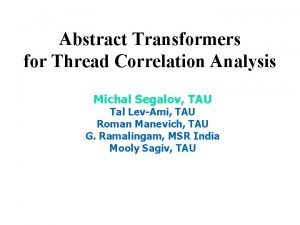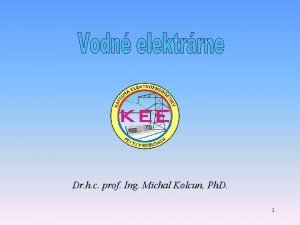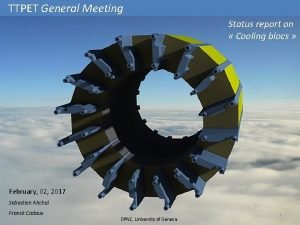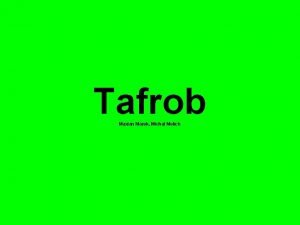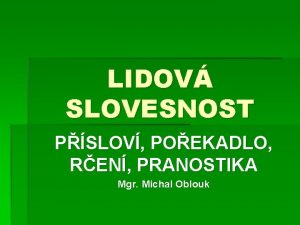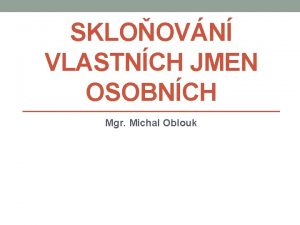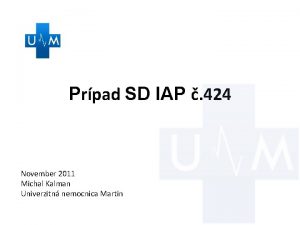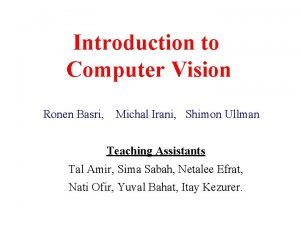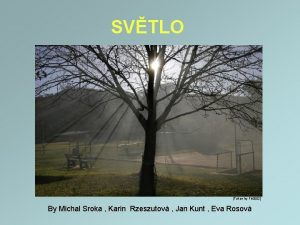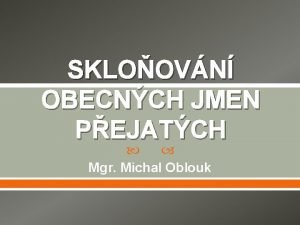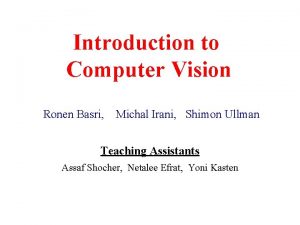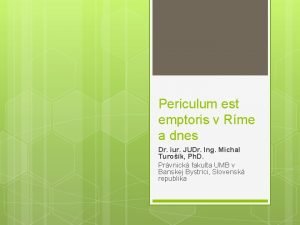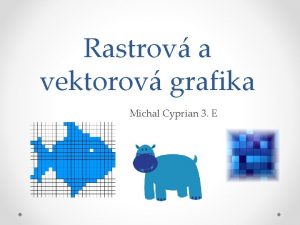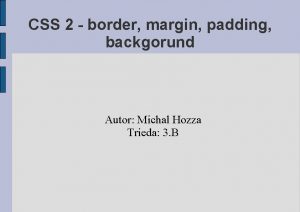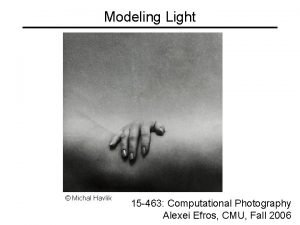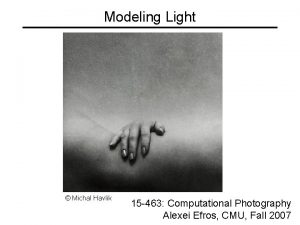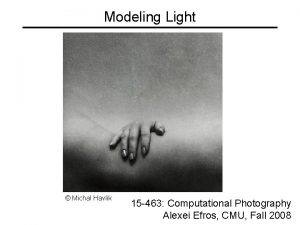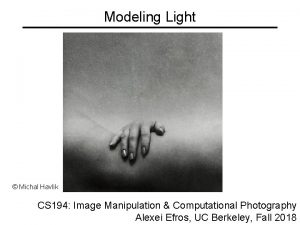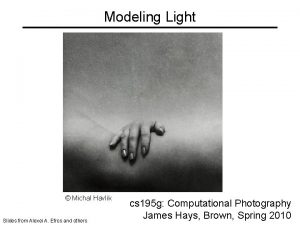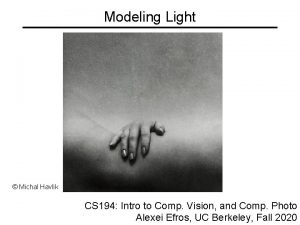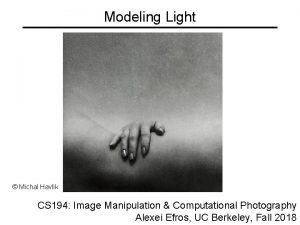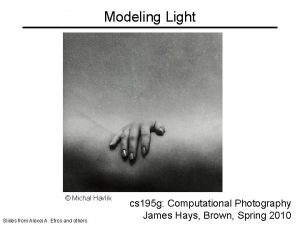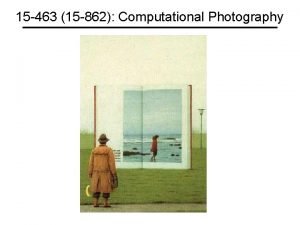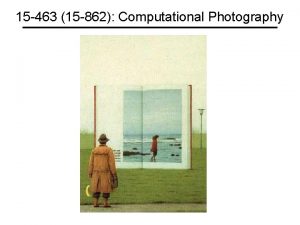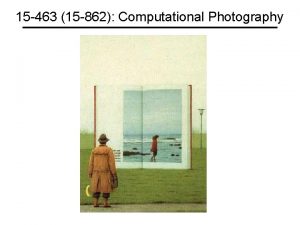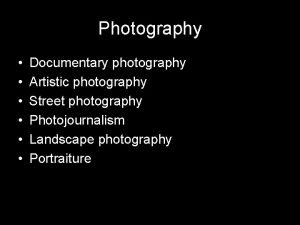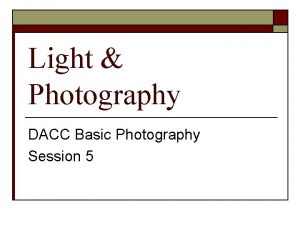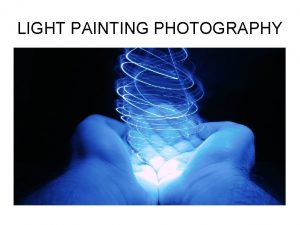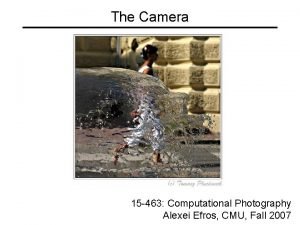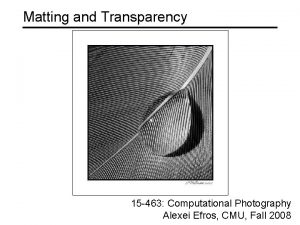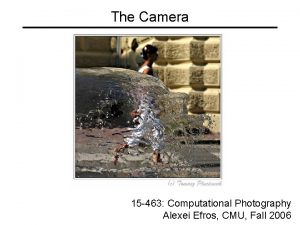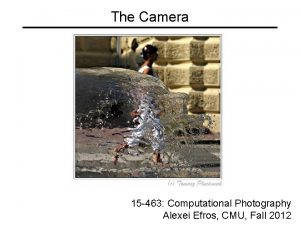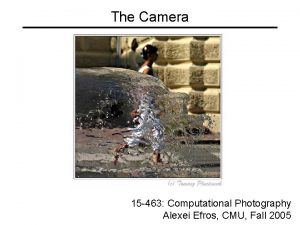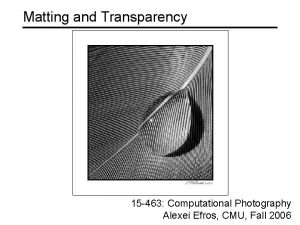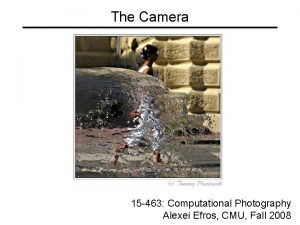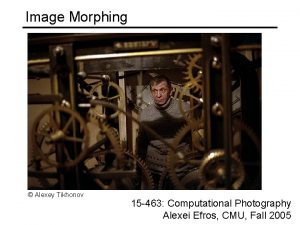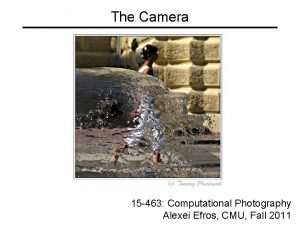Modeling Light Michal Havlik 15 463 Computational Photography





















































- Slides: 53

Modeling Light © Michal Havlik 15 -463: Computational Photography Alexei Efros, CMU, Fall 2011

What is light? Electromagnetic radiation (EMR) moving along rays in space • R(l) is EMR, measured in units of power (watts) – l is wavelength Light: • • Travels far Travels fast Travels in straight lines Interacts with stuff Bounces off things Is produced in nature Has lots of energy -- Steve Shafer

What do we see? 3 D world 2 D image Figures © Stephen E. Palmer, 2002

What do we see? 3 D world Painted backdrop 2 D image

On Simulating the Visual Experience Just feed the eyes the right data • No one will know the difference! Philosophy: • Ancient question: “Does the world really exist? ” Science fiction: • Many, many books on the subject, e. g. slowglass from “Light of Other Days” • Latest take: The Matrix Physics: • Slowglass might be possible? Computer Science: • Virtual Reality To simulate we need to know: What does a person see?

The Plenoptic Function Figure by Leonard Mc. Millan Q: What is the set of all things that we can ever see? A: The Plenoptic Function (Adelson & Bergen) Let’s start with a stationary person and try to parameterize everything that he can see…

Grayscale snapshot P(q, f) is intensity of light • Seen from a single view point • At a single time • Averaged over the wavelengths of the visible spectrum (can also do P(x, y), but spherical coordinate are nicer)

Color snapshot P(q, f, l) is intensity of light • Seen from a single view point • At a single time • As a function of wavelength

A movie P(q, f, l, t) is intensity of light • Seen from a single view point • Over time • As a function of wavelength

Holographic movie P(q, f, l, t, VX, VY, VZ) is intensity of light • Seen from ANY viewpoint • Over time • As a function of wavelength

The Plenoptic Function P(q, f, l, t, VX, VY, VZ) • Can reconstruct every possible view, at every moment, from every position, at every wavelength • Contains every photograph, every movie, everything that anyone has ever seen! it completely captures our visual reality! Not bad for a function…

Sampling Plenoptic Function (top view) Just lookup -- Quicktime VR

Ray Let’s not worry about time and color: P(q, f, VX, VY, VZ) 5 D • 3 D position • 2 D direction Slide by Rick Szeliski and Michael Cohen

How can we use this? Lighting No Change in Radiance Surface Camera

Ray Reuse Infinite line • Assume light is constant (vacuum) 4 D • 2 D direction • 2 D position • non-dispersive medium Slide by Rick Szeliski and Michael Cohen

Only need plenoptic surface

Synthesizing novel views Slide by Rick Szeliski and Michael Cohen

Lumigraph / Lightfield Outside convex space Empty 4 D Stuff Slide by Rick Szeliski and Michael Cohen

Lumigraph - Organization 2 D position 2 D direction q s Slide by Rick Szeliski and Michael Cohen

Lumigraph - Organization 2 D position s u 2 plane parameterization Slide by Rick Szeliski and Michael Cohen

Lumigraph - Organization 2 D position s, t t u, v s, t v u, v 2 plane parameterization s u Slide by Rick Szeliski and Michael Cohen

Lumigraph - Organization Hold s, t constant Let u, v vary An image s, t u, v Slide by Rick Szeliski and Michael Cohen

Lumigraph / Lightfield

Lumigraph - Capture Idea 1 • Move camera carefully over s, t plane • Gantry – see Lightfield paper s, t u, v Slide by Rick Szeliski and Michael Cohen

Lumigraph - Capture Idea 2 • Move camera anywhere • Rebinning – see Lumigraph paper s, t u, v Slide by Rick Szeliski and Michael Cohen

Lumigraph - Rendering q For each output pixel • determine s, t, u, v • either • use closest discrete RGB • interpolate near values s u Slide by Rick Szeliski and Michael Cohen

Lumigraph - Rendering Nearest • closest s • closest u • draw it Blend 16 nearest • quadrilinear interpolation s u Slide by Rick Szeliski and Michael Cohen

Stanford multi-camera array • 640 × 480 pixels × 30 fps × 128 cameras • synchronized timing • continuous streaming • flexible arrangement

Light field photography using a handheld plenoptic camera Ren Ng, Marc Levoy, Mathieu Brédif, Gene Duval, Mark Horowitz and Pat Hanrahan

Conventional versus light field camera Ó 2005 Marc Levoy

Conventional versus light field camera uv-plane st-plane Ó 2005 Marc Levoy

Prototype camera Contax medium format camera Kodak 16 -megapixel sensor Adaptive Optics microlens array 125μ square-sided microlenses • 4000 × 4000 pixels ÷ 292 × 292 lenses = 14 × 14 pixels per lens


Digitally stopping-down Σ Σ • stopping down = summing only the central portion of each microlens Ó 2005 Marc Levoy

Digital refocusing Σ Σ • refocusing = summing windows extracted from several microlenses Ó 2005 Marc Levoy

Example of digital refocusing Ó 2005 Marc Levoy

Digitally moving the observer Σ Σ • moving the observer = moving the window we extract from the microlenses Ó 2005 Marc Levoy

Example of moving the observer Ó 2005 Marc Levoy

Moving backward and forward Ó 2005 Marc Levoy

On sale now: lydra. com Ó 2005 Marc Levoy

3 D Lumigraph One row of s, t plane • i. e. , hold t constant s, t u, v

3 D Lumigraph One row of s, t plane • i. e. , hold t constant • thus s, u, v • a “row of images” s u, v

P(x, t) by David Dewey

2 D: Image What is an image? All rays through a point • Panorama? Slide by Rick Szeliski and Michael Cohen

Image plane 2 D • position

Spherical Panorama See also: 2003 New Years Eve http: //www. panoramas. dk/fullscreen 3/f 1. html All light rays through a point form a ponorama Totally captured in a 2 D array -- P(q, f) Where is the geometry? ? ?

Other ways to sample Plenoptic Function Moving in time: • Spatio-temporal volume: P(q, f, t) • Useful to study temporal changes • Long an interest of artists: Claude Monet, Haystacks studies

Space-time images Other ways to slice the plenoptic function… t y x

The “Theatre Workshop” Metaphor (Adelson & Pentland, 1996) desired image Painter Lighting Designer Sheet-metal worker

Painter (images)

Lighting Designer (environment maps) Show Naimark SF MOMA video http: //www. debevec. org/Naimark/naimark-displacements. mov

Sheet-metal Worker (geometry) Let surface normals do all the work!

… working together clever Italians Want to minimize cost Each one does what’s easiest for him • Geometry – big things • Images – detail • Lighting – illumination effects
 Computational engineering and physical modeling
Computational engineering and physical modeling Computational photography uiuc
Computational photography uiuc Computational photography uiuc
Computational photography uiuc Math 463
Math 463 Ds hakvoort
Ds hakvoort Gcb registration
Gcb registration Opwekking 463
Opwekking 463 What is multiplicand and multiplier example
What is multiplicand and multiplier example Light light light chapter 22
Light light light chapter 22 Light light light chapter 23
Light light light chapter 23 Light light light chapter 22
Light light light chapter 22 Erickson nursing theory
Erickson nursing theory Dimensional modeling vs relational modeling
Dimensional modeling vs relational modeling Is abstract photography same as conceptual photography
Is abstract photography same as conceptual photography Light and matter photography
Light and matter photography Light graffiti photography
Light graffiti photography Paramount light
Paramount light Michal drobot
Michal drobot Michal hammer
Michal hammer Michal kolcun
Michal kolcun Michal segalov
Michal segalov Michal kolcun
Michal kolcun Ttpet
Ttpet Michal grešlik
Michal grešlik Michal hrab
Michal hrab Michal melich
Michal melich Michal skloňování
Michal skloňování Michal pranostika
Michal pranostika Meniny michala
Meniny michala Michal lehnert
Michal lehnert Michal kompan
Michal kompan Michal veselovsky
Michal veselovsky Hrábě skloňování vzor
Hrábě skloňování vzor Michal kalman vek
Michal kalman vek Michal irani
Michal irani Michal sroka
Michal sroka Michal skloňování
Michal skloňování Michal unzeitig
Michal unzeitig Michal shinnar
Michal shinnar Michal bick
Michal bick Michal tkaczyk
Michal tkaczyk Michal irani
Michal irani Michal vajcik
Michal vajcik Michal skloňování
Michal skloňování Periculum est emptoris
Periculum est emptoris Michal cyprian
Michal cyprian Css backgorund
Css backgorund Michal heczko
Michal heczko Michal avny
Michal avny Michal inbar-feigenberg
Michal inbar-feigenberg Krátky ľudový výrok z ktorého vyplýva ponaučenie
Krátky ľudový výrok z ktorého vyplýva ponaučenie Adsl standard
Adsl standard Dr. matilda a. evans
Dr. matilda a. evans Michal sipko
Michal sipko

